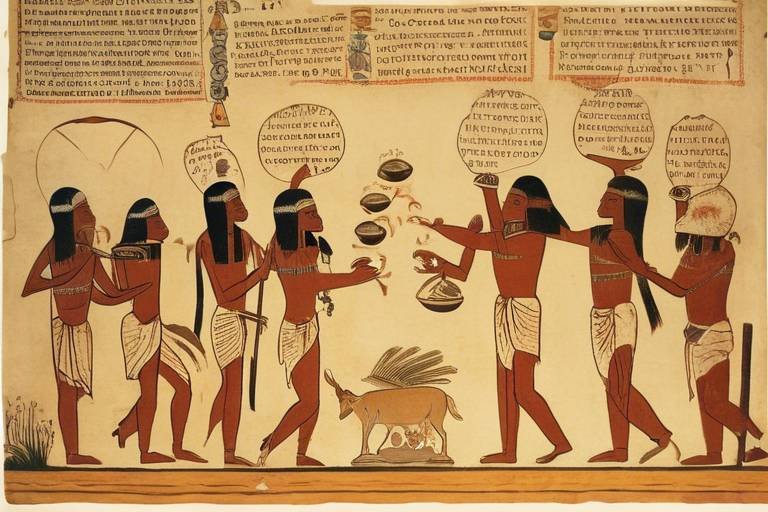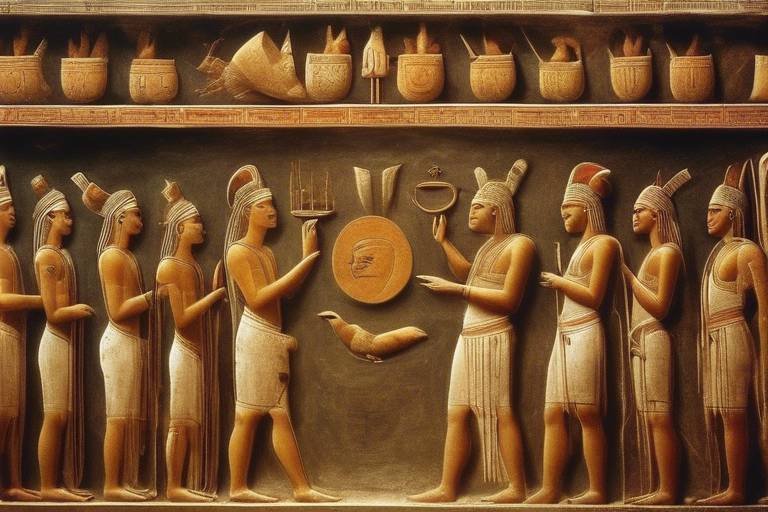The Role of Digital Storytelling in Heritage Awareness
Exploring how digital storytelling can be utilized to increase awareness and appreciation of cultural heritage sites and traditions, preserving them for future generations.

Preserving Cultural Heritage
Exploring how digital storytelling can be utilized to increase awareness and appreciation of cultural heritage sites and traditions, preserving them for future generations.
Preserving cultural heritage is crucial in maintaining the identity and history of societies worldwide. Through digital storytelling, the rich tapestry of cultural traditions, historical landmarks, and unique practices can be documented and safeguarded for future generations. By digitizing and immortalizing these elements, we ensure that the essence of our past is not lost but rather celebrated and passed down to posterity.

Engaging Audiences
Digital storytelling has the remarkable ability to captivate audiences and forge emotional connections to heritage sites and traditions. By weaving together narratives, visuals, and interactive elements, digital storytelling can transport viewers to different eras and cultures, immersing them in the rich tapestry of our collective heritage.
Imagine standing in the midst of an ancient temple or witnessing a traditional dance performance through the power of digital storytelling. The vivid imagery and compelling storytelling can evoke a sense of wonder and appreciation for cultural heritage, making it more accessible and engaging to audiences of all ages.
Through digital platforms, individuals from across the globe can virtually explore heritage sites and experience cultural traditions firsthand. This global reach not only promotes cross-cultural understanding but also fosters a sense of unity and interconnectedness among diverse communities.
Moreover, digital storytelling empowers local communities to share their unique heritage stories with the world, preserving their cultural identity and traditions for future generations. By giving voice to marginalized narratives and untold histories, digital platforms become powerful tools for community empowerment and cultural preservation.
By harnessing the latest technological advancements such as virtual reality, augmented reality, and interactive multimedia, digital storytelling offers immersive and engaging experiences that enhance learning about cultural heritage. These innovative tools transform passive viewers into active participants, enabling them to explore heritage sites in a dynamic and interactive manner.

Interactive Learning
Exploring how digital storytelling can be utilized to increase awareness and appreciation of cultural heritage sites and traditions, preserving them for future generations.
Interactive learning through digital storytelling offers a dynamic and immersive way to engage with cultural heritage. By incorporating interactive elements such as virtual tours, 360-degree videos, and augmented reality experiences, users can delve deep into the history and significance of heritage sites.
Imagine walking through the ancient ruins of Machu Picchu or exploring the intricate architecture of the Taj Mahal from the comfort of your own home. These interactive experiences not only educate but also spark curiosity and a sense of wonder, making learning about cultural heritage a truly captivating journey.
Furthermore, interactive learning allows for personalized exploration, enabling users to choose their own path and delve into specific aspects of heritage that interest them the most. This hands-on approach to learning fosters a deeper understanding and connection to the cultural significance of heritage sites and traditions.
Through interactive digital storytelling, users can actively participate in the preservation and dissemination of cultural heritage, becoming virtual explorers and storytellers in their own right. This engagement not only enhances learning but also cultivates a sense of ownership and responsibility towards safeguarding our shared cultural legacy.

Global Reach
Exploring how digital storytelling can be utilized to increase awareness and appreciation of cultural heritage sites and traditions, preserving them for future generations.
When it comes to heritage awareness, one of the most remarkable aspects of digital storytelling is its ability to transcend geographical boundaries and connect with a global audience. Through the power of digital platforms, stories of cultural heritage from every corner of the world can be shared and appreciated by individuals across continents. This global reach allows for the preservation and celebration of diverse heritage sites and traditions on a scale never before possible. Imagine a virtual journey where you can explore the pyramids of Egypt, witness the vibrant colors of Indian festivals, or experience the ancient rituals of indigenous tribes in South America, all from the comfort of your own home.

Community Empowerment
Community empowerment through digital storytelling is a powerful tool that allows local residents to take ownership of their cultural heritage and share their unique stories with the world. By utilizing digital platforms, communities can preserve their traditions and customs in a way that is easily accessible to a global audience.
Digital storytelling empowers communities by providing them with a voice to express their identity and history. Through engaging narratives and multimedia elements, individuals can showcase the richness of their cultural heritage, fostering a sense of pride and connection within the community.
Furthermore, the collaborative nature of digital storytelling encourages community members to work together towards a common goal of preserving and promoting their heritage. By sharing stories and memories, residents can strengthen bonds and create a collective memory that transcends generations.
One effective way to empower communities through digital storytelling is to establish local heritage initiatives that involve residents in the creation and curation of content. This hands-on approach not only fosters a sense of ownership but also instills a deeper appreciation for the cultural significance of heritage sites and traditions.
In addition to preserving cultural identity, community empowerment through digital storytelling can also have economic benefits. By showcasing their heritage in an engaging and interactive way, communities can attract tourists and visitors, leading to increased economic opportunities and sustainable development.

Technological Advancements
In the realm of heritage awareness, technological advancements have revolutionized the way we interact with and preserve cultural heritage. The integration of cutting-edge technologies such as virtual reality (VR), augmented reality (AR), and artificial intelligence (AI) has opened up new possibilities for storytelling. Through VR, individuals can immerse themselves in virtual recreations of historical sites, experiencing the past in a way that was once unimaginable. AR overlays digital information onto the physical world, providing interactive experiences at heritage sites. AI algorithms can analyze vast amounts of data to uncover hidden insights about cultural artifacts and traditions, enriching the storytelling experience.
Furthermore, the rise of mobile applications and online platforms has democratized the creation and sharing of heritage stories. Anyone with a smartphone can now capture and share their cultural heritage in an instant, contributing to a collective digital archive of global significance. Social media platforms have also played a crucial role in amplifying heritage awareness, allowing stories to reach a wide audience in a matter of seconds. These technological advancements have not only made heritage storytelling more accessible but have also enhanced its impact, fostering a deeper connection between individuals and their cultural roots.

Challenges and Solutions
When it comes to utilizing digital storytelling for heritage awareness, several challenges may arise, hindering the effectiveness of such initiatives. One significant challenge is the digital divide, where not all communities have equal access to technology and the internet. This can limit the reach of digital storytelling efforts and exclude certain populations from engaging with their cultural heritage.
Another common challenge is balancing authenticity with creativity in digital storytelling. While it's essential to present heritage sites and traditions accurately, there is also a need to make the content engaging and appealing to modern audiences. Striking this balance can be tricky but is crucial for capturing and maintaining audience interest.
Moreover, preservation of digital content poses a challenge, as technologies and file formats evolve rapidly. Ensuring the long-term accessibility and usability of digital storytelling materials requires ongoing maintenance and updates to prevent content from becoming obsolete.
One solution to the digital divide challenge is to partner with local organizations and community centers to facilitate access to technology and digital resources. By collaborating with grassroots initiatives, digital storytelling projects can ensure that a broader range of individuals can participate and benefit from heritage awareness efforts.
To address the authenticity versus creativity dilemma, content creators can incorporate user-generated content and interactive elements into digital storytelling experiences. By allowing audiences to contribute their perspectives and interpretations, the narrative becomes more dynamic and inclusive, fostering a sense of ownership and engagement.
For the preservation of digital content, implementing metadata standards and regular backups can help safeguard storytelling materials against technological obsolescence. By adhering to industry best practices for digital archiving, organizations can ensure the longevity and accessibility of heritage awareness content.
Overall, while challenges exist in leveraging digital storytelling for heritage awareness, innovative solutions and strategic partnerships can overcome these obstacles, paving the way for more inclusive and impactful initiatives.

Educational Impact
Exploring how digital storytelling can be utilized to increase awareness and appreciation of cultural heritage sites and traditions, preserving them for future generations.
Highlighting the importance of using digital storytelling to document and safeguard cultural heritage from around the world.
Discussing how digital storytelling can captivate audiences and create emotional connections to heritage sites and traditions.
Exploring how interactive digital storytelling experiences can enhance learning about cultural heritage in an engaging and immersive way.
Examining how digital storytelling can transcend geographical boundaries, allowing heritage awareness to reach a global audience.
Discussing how digital storytelling can empower local communities to share their heritage stories and preserve their cultural identity.
Exploring the latest technological tools and innovations that enhance the digital storytelling experience for heritage awareness.
Addressing the challenges faced in using digital storytelling for heritage awareness and proposing solutions to overcome them.
Discussing the educational benefits of incorporating digital storytelling into heritage awareness initiatives and academic curricula.
Frequently Asked Questions
- What is digital storytelling?
Digital storytelling is the practice of using digital tools such as images, videos, and audio to tell a story. It combines traditional storytelling techniques with multimedia elements to create engaging narratives.
- How can digital storytelling help preserve cultural heritage?
Digital storytelling can help preserve cultural heritage by documenting and sharing stories, traditions, and historical information in a visually compelling and accessible way. It allows for the digital preservation of cultural artifacts and practices for future generations.
- Why is engaging audiences important in heritage awareness?
Engaging audiences is crucial in heritage awareness as it fosters emotional connections and personal relevance to cultural heritage sites and traditions. It helps create a sense of ownership and responsibility towards preserving and promoting cultural heritage.
- How does digital storytelling enhance interactive learning?
Digital storytelling enhances interactive learning by providing immersive and engaging experiences that allow users to explore cultural heritage in a dynamic way. It encourages active participation and deepens understanding through interactive elements.
- What are some challenges faced in using digital storytelling for heritage awareness?
Some challenges include ensuring digital accessibility for all audiences, maintaining authenticity in storytelling, and overcoming technological barriers. However, these challenges can be addressed through careful planning and innovative solutions.



















